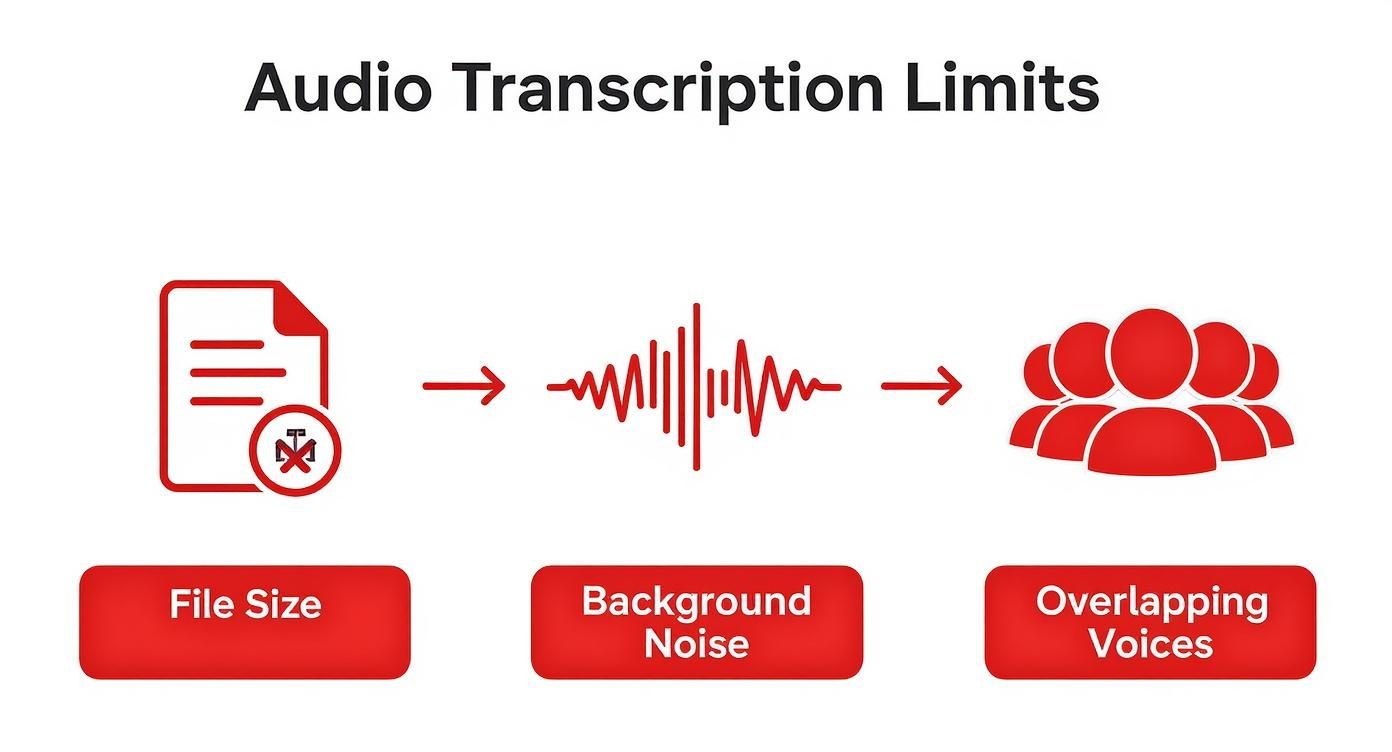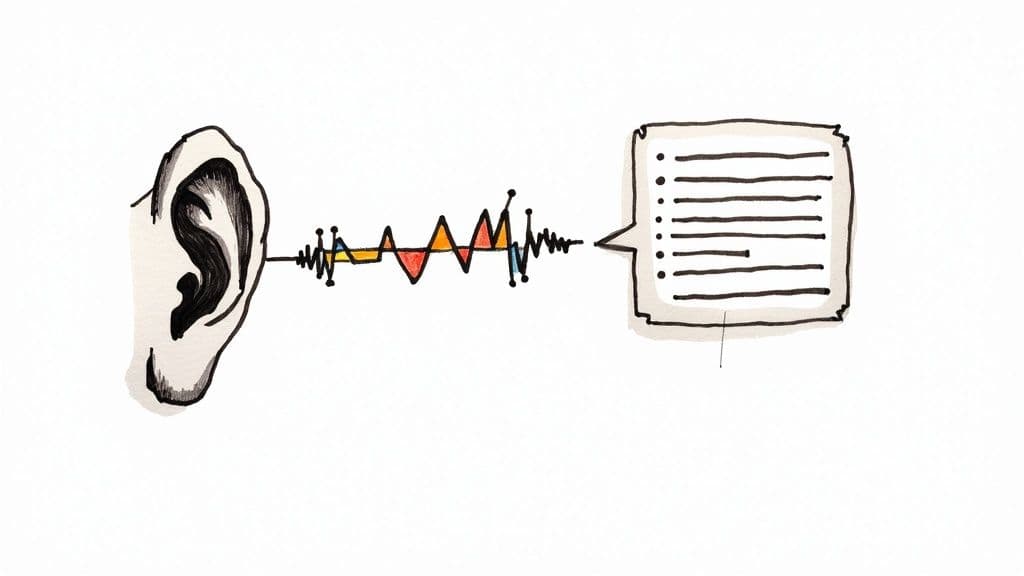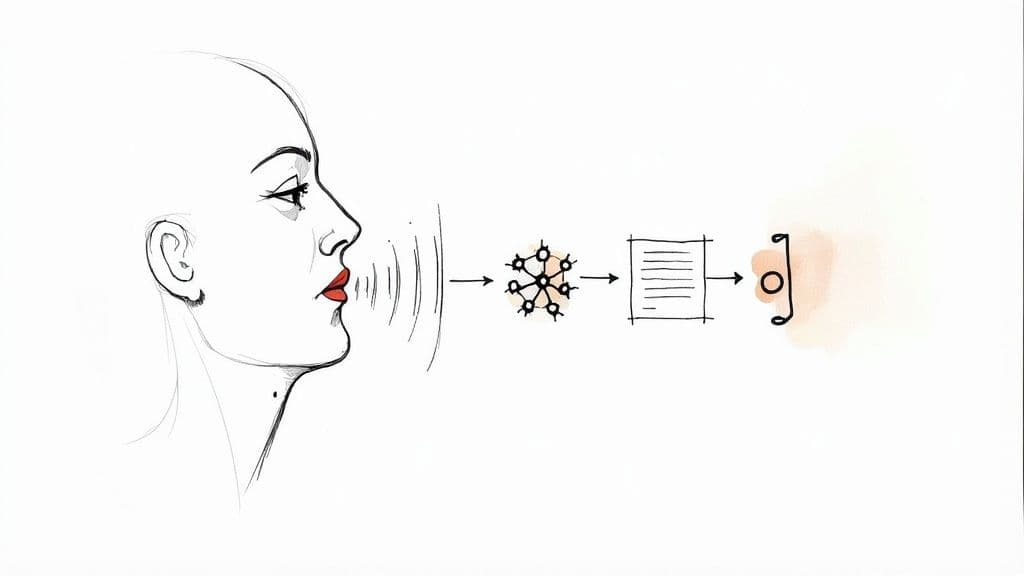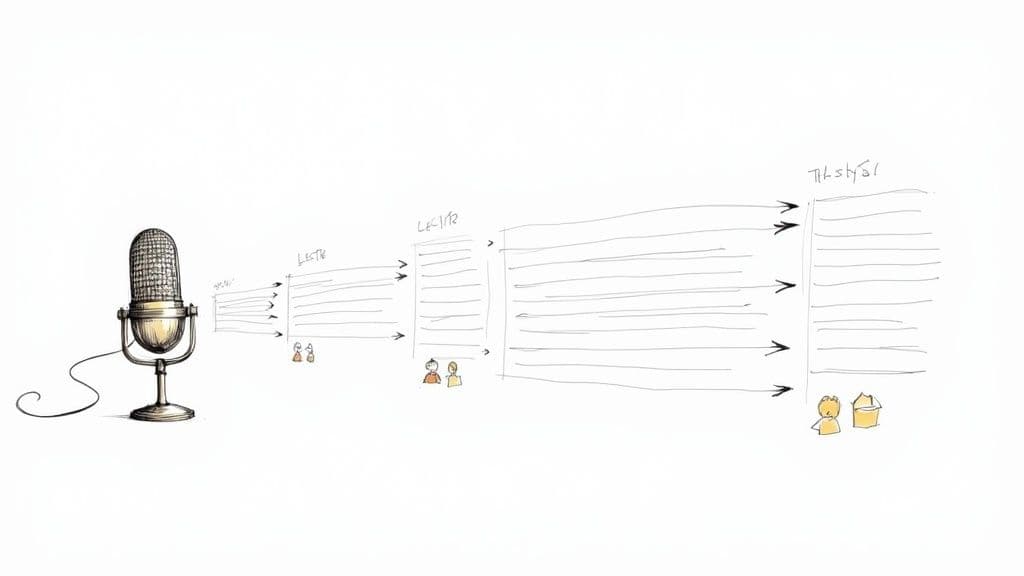Yes, ChatGPT can transcribe audio, but there's a catch: you can’t simply upload an audio file to the standard ChatGPT chat window. The transcription capability comes from a separate, powerful OpenAI technology called Whisper.
The Simple Answer: It's a Team Effort
Think of it like this: Whisper is the specialized 'ears' of the operation, an AI model built specifically to convert speech to text. ChatGPT is the 'brain' that can then summarize, analyze, translate, or reformat that text. They work together, but the core task of audio transcription is handled by Whisper.
So, while the answer to "can ChatGPT transcribe audio" is yes, it's important to know you can't use the standard chat interface for audio files. That window is strictly for text-based prompts.

To transcribe audio using ChatGPT technology, you need to use a method that connects to OpenAI's audio processing ecosystem.
How Does ChatGPT Transcribe Audio in Practice?
The engine that makes ChatGPT audio transcription possible is OpenAI's Whisper API, a sophisticated automatic speech recognition (ASR) system. It was trained on an incredible 680,000 hours of diverse audio from across the internet. This massive dataset allows Whisper to understand speech, accents, and jargon in over 50 languages with high accuracy. As detailed in this breakdown of the audio processing on Notta.ai, the system processes audio by breaking it into 30-second segments and converting them to text.
To help you navigate your options for audio transcription, we've created a summary table.
ChatGPT Transcription Methods At a Glance
This table breaks down the main ways to use OpenAI's audio-to-text technology, helping you choose the best tool for your transcription needs.
| Method | Best For | Ideal User |
|---|---|---|
| ChatGPT Voice Feature (Mobile App) | Live voice-to-text conversations and dictating ideas on the go. | Individuals who need to quickly turn spoken thoughts into text notes. |
| OpenAI Whisper API | Transcribing pre-recorded audio files like interviews, meetings, or podcasts. | Developers, businesses, or anyone needing to programmatically process audio files. |
| Dedicated Transcription Service (using Whisper) | High-volume or professional transcription needing features like speaker labels and multiple export formats. | Professionals, researchers, and content creators who need a polished transcript without any coding. |
By understanding the relationship between ChatGPT (the text processor) and Whisper (the audio transcriber), you can effectively turn your audio recordings into accurate, usable text. Whether it's through the app's live voice feature or a service that leverages the Whisper API, the ability to transcribe audio with ChatGPT is readily available.
So, How Does ChatGPT Actually Transcribe Anything? Meet Whisper

To fully understand how ChatGPT can transcribe audio, you need to look at the technology working behind the scenes. The real star of the show for audio-to-text conversion is not ChatGPT itself, but a specialized OpenAI model called Whisper.
Think of Whisper as a world-class interpreter. Its only job is to listen to spoken words in an audio file and convert them into written text. ChatGPT is the brilliant analyst who then takes that text and transforms it into a summary, a blog post, a social media update, or a list of action items.
They are two distinct AI specialists working in tandem. Whisper handles the raw audio transcription with impressive accuracy, and ChatGPT provides the intelligence to analyze and manipulate the resulting text. This is the core of how ChatGPT audio transcription works.
How Whisper Got So Good at Audio Transcription
Whisper's high accuracy isn't an accident. OpenAI trained it on a massive and diverse dataset of 680,000 hours of audio from various sources online.
This training data wasn't just clean, studio-quality audio. It was messy and reflected real-world conditions, including:
- Languages and Accents: It learned to recognize speech patterns from around the globe, making it a powerful tool for transcribing diverse speakers.
- Background Noise: The model was trained to isolate voices from distracting sounds like cafes, traffic, and poor-quality conference calls.
- Technical Jargon: Its training included specialized terminology from numerous industries, so it can accurately transcribe complex topics.
This is why the transcripts are so good. Whisper creates high-quality text from audio, and then ChatGPT can work its magic on it. If you want to dive deeper into the basics of this process, check out our guide on audio-to-text technology.
By understanding that Whisper handles the audio transcription and ChatGPT handles the text processing, you can better appreciate the two-step workflow that makes this technology so effective for turning conversations into actionable content.
So, when we ask if ChatGPT can transcribe audio, the answer is more nuanced than a simple "yes." The platform provides access to the feature, but it’s a tag-team effort powered by Whisper’s specialized listening skills.
What Are the Limitations of ChatGPT's Audio Transcription?
While the technology behind ChatGPT's audio transcription is impressive, it has limitations. Understanding these real-world constraints is key to avoiding frustration and knowing when it's the right tool for the job.
The first major hurdle is the file size limit. The Whisper API, which powers this feature, has a strict cap of 25 MB per file. This typically equates to only 15-20 minutes of good-quality audio. You can't upload an hour-long podcast or meeting and expect a single transcript. For longer recordings, you must first split the audio into smaller chunks, which adds an extra, time-consuming step to your workflow.
Beyond file size, the quality of your audio is paramount. The model's transcription accuracy drops significantly if the sound isn't clear.
Common Issues That Reduce Transcription Accuracy
Even if your file is under the size limit, several real-world factors can degrade the quality of your transcript. Think of Whisper as an attentive listener—if the environment is noisy or chaotic, it will struggle to understand.
Here are the most common problems:
- Background Noise: Sounds from a busy cafe, street traffic, or even a loud air conditioner can interfere with the transcription.
- Multiple Speakers: The model struggles to differentiate between speakers, especially when they talk over one another. It does not provide speaker labels (diarization), resulting in a single, jumbled block of text.
- Thick Accents or Fast Speech: While trained on diverse data, strong accents or rapid speech can still reduce the transcription accuracy.
Poor audio quality is the leading cause of frustration with AI transcription. To give ChatGPT the best chance of success, it’s crucial to enhance audio clarity by removing background noise before uploading. Cleaning up your audio file first can make a significant difference.
In short, for the best results with ChatGPT audio transcription, you need clean audio with minimal background noise and clear speakers. As noted in the insights on ChatGPT transcription on GetCockpit.io, these factors are crucial for reliable output. Knowing these limitations helps you set realistic expectations for your transcription projects.
A Step-by-Step Guide to Transcribing Audio Files with ChatGPT
Now that you understand the technology and its limitations, let's walk through how to transcribe audio with OpenAI's tools. There are two primary methods, depending on whether you're capturing live speech or processing a pre-recorded audio file.
Method 1: Using the ChatGPT Mobile App for Live Audio Transcription
The fastest way to turn spoken words into text is by using the voice feature integrated into the ChatGPT mobile app. This method is ideal for dictating notes, brainstorming ideas, or capturing a live conversation.
- Open the App: Launch the ChatGPT app on your iOS or Android device.
- Tap the Headphone Icon: This activates the voice conversation mode.
- Start Speaking: ChatGPT will listen and transcribe your words in near real-time.
- End the Session: Once you stop talking, the entire conversation is saved as a text transcript in your chat history. You can then copy, edit, or ask ChatGPT to summarize the text.
This process is perfect for on-the-go audio transcription. However, it does not support uploading existing audio files like MP3s or WAVs. For that, you'll need the second method.
Method 2: Using the Whisper API for Pre-Recorded Audio Files
If you have a pre-recorded audio file, you must use the Whisper API. While "API" might sound technical, many user-friendly tools have integrated Whisper, so you don't need to write any code. The basic workflow remains the same.
- Prepare Your Audio File: Ensure your file is in a supported format (like MP3, WAV, or MP4) and under the 25 MB size limit.
- Upload Your File: Use a third-party service or a simple script to send your audio file to the Whisper API for processing.
- Receive Your Transcript: The API will process the audio and return a plain text file of the transcription.
This infographic highlights the key factors affecting audio transcription quality.

As you can see, achieving a high-quality transcript starts with high-quality audio. To ensure the best possible result, it's a good practice to learn how to improve audio quality before you begin the transcription process.
Unlock the Power of Your Transcribed Text
Getting the audio transcription is just the first step. The real value is unlocked when you use ChatGPT to process that raw text, turning a lengthy document into actionable insights. This is where the synergy of Whisper and ChatGPT truly shines.
Once you have your text transcript, the possibilities are vast. Instead of manually reading through hours of dialogue, you can use ChatGPT to do the heavy lifting. This combination transforms a tedious manual task into a fast, efficient one. Businesses can save significant time; one estimate suggests organizations waste nearly 48 minutes daily on manual transcription tasks, adding up to almost 4 hours per week.
From Raw Audio Transcription to Polished Content
Imagine you have a two-hour interview transcript. Instead of rereading it, you can use a simple prompt to get exactly what you need in seconds.
Here are a few real-world examples of how you can use ChatGPT with your audio transcript:
- Summarize Key Points: "Summarize the main arguments and conclusions from this interview transcript."
- Extract Action Items: "From this project meeting transcript, extract all action items, deadlines, and assigned individuals."
- Repurpose for a Blog Post: "Convert this podcast transcript into a well-structured, 800-word blog post with SEO-friendly headings."
- Identify Core Themes: "Analyze this customer feedback transcript and identify the top three most common themes or complaints."
This workflow is a game-changer for content creators, researchers, marketers, and other professionals. The key isn't just that ChatGPT can transcribe audio; it's what you can do with the text afterward that creates immense value.
Transcription is just one piece of the content puzzle. You can explore other top AI tools for content creators to help you process, polish, and distribute your content across multiple platforms.
When to Use a Dedicated Transcription Service Instead
While the ChatGPT and Whisper combination is excellent for quick and affordable audio transcription, it is not the ideal solution for every situation. For tasks requiring high accuracy, security, or advanced features, a dedicated transcription service is the smarter and safer choice.
Knowing when to opt for a professional service is crucial, especially when dealing with sensitive information or projects where precision is paramount.
Knowing When to Call in the Pros
When accuracy is non-negotiable, a dedicated service is essential. For legal depositions, medical dictation, or academic research, even a single misinterpreted word can have serious consequences. These fields require near-perfect accuracy, often needing a human review to achieve a 99% or higher success rate—a standard that fully automated systems cannot consistently meet.
Another significant factor is audio complexity. ChatGPT's transcription via Whisper cannot identify different speakers, a feature known as diarization. If you are transcribing a focus group, a multi-person interview, or a meeting where people talk over each other, you will receive a single, undifferentiated block of text, making it difficult to follow the conversation.
Consider these scenarios where a dedicated service is superior:
- High-Stakes Accuracy: Legal proceedings, medical records, and academic research where every word matters.
- Speaker Identification (Diarization): When you need to know exactly who said what in recordings with multiple speakers.
- Enhanced Security & Compliance: For confidential business meetings or sensitive client data requiring strict privacy protocols and NDAs.
- Guaranteed Turnaround Times: When you have a firm deadline and cannot risk technical issues or delays.
Ultimately, the decision comes down to balancing risk and convenience. For casual notes or brainstorming, ChatGPT is a brilliant tool. However, for any professional, confidential, or complex audio file, a dedicated service provides the accuracy, security, and specialized features that an AI-only workflow cannot match.
Many professionals find that using an audio to text converter designed for these specific needs saves time and prevents costly errors. The table below provides a clear comparison to help you choose the right solution for your project.
ChatGPT Transcription vs Dedicated Services
When weighing your audio transcription options, a direct comparison is helpful. On one side, you have the raw, fast, and low-cost power of an API. On the other, you have a service designed to handle the complexities of professional audio.
| Feature | ChatGPT (via Whisper API) | Dedicated Transcription Service |
|---|---|---|
| Accuracy | High, but varies with audio quality | Up to 99%+ with human verification |
| Speaker ID | Not available (no diarization) | Standard feature for multi-speaker files |
| Security | Standard data policies | Enhanced security, NDAs, and compliance options |
| Cost | Very low (pay-per-minute) | Higher, with per-minute or per-hour rates |
| Turnaround | Nearly instant | Varies (minutes to days) |
| Use Case | Quick notes, drafts, personal projects | Legal, medical, professional, and complex audio |
Each approach has its place. The key is understanding the trade-offs and selecting the tool that best fits the task. For any project requiring nuance, confidentiality, or pinpoint accuracy, a professional service is almost always the right choice.
A Few Lingering Questions About ChatGPT Transcription
Still considering whether ChatGPT is the right tool for your audio transcription needs? Let's answer some of the most common questions to help you decide.
Is Transcribing Audio with ChatGPT Actually Free?
It depends. Using the live voice-to-text feature in the free ChatGPT mobile app does not have an additional cost. It is an included feature.
However, if you have a pre-recorded audio file (like an MP3 or WAV), you must use the Whisper API. This is a paid service from OpenAI. While it is highly affordable and priced per minute of audio, it is not free for transcribing files.
What Languages Can ChatGPT Handle for Audio Transcription?
This is a major strength of the technology. The Whisper model is a linguistic powerhouse, supporting audio transcription in over 50 languages.
This includes common languages like English, Spanish, and French, as well as German, Chinese, Japanese, and many others. Whisper is also highly effective at auto-detecting the language being spoken and can even translate many of them directly into English during the transcription process.
The real question isn't just can ChatGPT transcribe audio, but how effectively it handles the diverse, multilingual audio found in the real world. Whisper's extensive training gives it a significant advantage here.
Just How Accurate Is ChatGPT Audio Transcription?
Under ideal conditions, the accuracy is remarkable. For a crystal-clear recording of a single speaker with no background noise, its performance is comparable to a human transcriber.
However, real-world audio is rarely perfect. Transcription quality can decrease significantly with factors such as:
- Poor audio from a low-quality microphone
- Background noise or music
- Multiple speakers talking simultaneously
- Strong, unfamiliar accents
For any mission-critical applications, such as legal or medical transcription, a human-verified service remains the better option to ensure accuracy and avoid costly mistakes.
Ready to skip the API and get fast, accurate transcripts without the fuss? MeowTxt turns your audio and video files into text in minutes, complete with speaker identification, AI summaries, and multiple export options. Try it free today and see how easy transcription can be.



